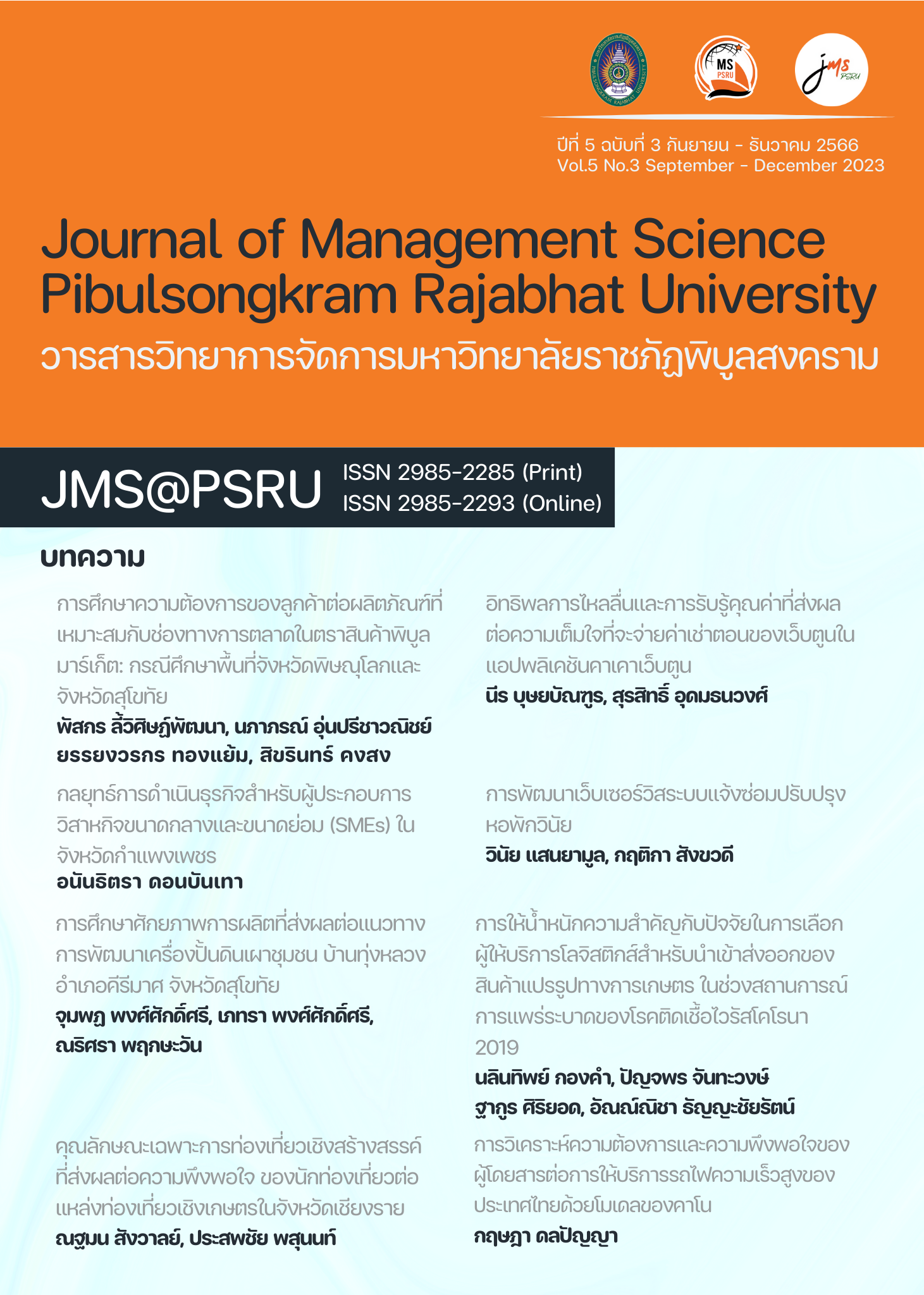Kano Model-Based Thai Passenger Needs and Satisfactions Analysis for High-Speed Rail Service
Keywords:
Kano model, High speed rail, Logistics performanceAbstract
This study aims to analyze the passenger needs and satisfaction towards Thailand's high-speed rail service using Kano Model. The Kano Model is a methodology used to categorize customer requirements into five categories: attraction, one-dimension, must-haves, no differences, and reversal. The data were collected from high-speed rail passengers through a survey using a Kano's two-directional questionnaire. Accidental sampling was used in this study. The sample consisted of 374 responses gathered from an online questionnaire via Google Forms. This study suggested that essential attributes related to logistics performance, such as time, cost, and reliability should be prioritized in order to meet customer satisfaction. The findings revealed that there was a difference between the age groups (41-60 years old and younger) in terms of attributes, which is a much-have type in terms of reliability, including the exact train schedule, safety officers, and train cleanliness. In addition, this study provides in-depth information about the attributes affecting the passengers’ needs and satisfaction that the high-speed train service providers can improve their services to meet the passengers’ needs effectively
References
การรถไฟแห่งประเทศไทย. (2562). 122 ปี ก้าวสู่อนาคตรถไฟไทย. สืบค้น 24 สิงหาคม 2565, จาก http://backup.co.th/srt/publication/122_Years_and_the_Future_of_SRT/report/index.html
กองโลจิสติกส์. (2562). Industrial Logistics Performance Index..Key Success Factor ตัวชี้วัดประสิทธิภาพด้านโลจิสติกส์..ปัจจัยสู่ความสำเร็จ. สืบค้น 24 สิงหาคม 2565, จากhttps://dol.dip.go.th/th/category/2019-02-08-08-57-30/2019-03-15-09-09-00
สำนักงานสภาพัฒนาการเศรษฐกิจและสังคมแห่งชาติ. (2562). รายงานโลจิสติกส์ของประเทศไทยประจำปี 2561. สืบค้น 24 สิงหาคม 2565, จาก https://www.nesdc.go.th/ewt_dl_link.php?nid=9359
Ardakani, A. S., Ghannad, S. B., Sadrabadi, M. M., & Shakerian, H. (2018). Service Design by Identification and Prioritization of Customer Demands in Kano Model: A Step Towards the Quality Function Deployment (QFD) and the Productivity Improvement. Industrial Engineering & Management Systems, 17(3), 600-612.
Berger, C., Blauth, R., & Boger, D. (1993). Kano’s Methods for Understanding Customer-Defined Quality. Center for Quality of Management Journal, 2(4), 3-36.
Blainey, S., Hickford, A., & Preston, J. (2012). Barriers to Passenger Rail Use: A Review of the Evidence. Transport Reviews, 32(6), 675-696.
Chaudha, A., Jain, R., Singh, A., & Mishra, P. (2011). Integration of Kano’s Model into Quality Function Deployment (QFD). The International Journal of Advanced Manufacturing Technology, 53(5), 689-698.
Cheng, Y.-H. (2010). High-Speed Rail in Taiwan: New Experience and Issues for Future Development. Transport policy, 17(2), 51-63.
Eboli, L., & Mazzulla, G. (2015). Relationships Between Rail Passengers’ Satisfaction and Service Quality: A Framework for Identifying Key Service Factors. Public Transport, 7, 185-201.
Huang, C.-C., & Guan, S.-S. (2012). Application of Kano Model in Study of Satisfaction with Quality of Website Browsing Environment. Bulletin of Japanese Society for the Science of Design, 59(1), 49-58.
Ibrahim, A. N. H., Borhan, M. N., & Ismail, A. (2020). Rail-Based Public Transport Service Quality and User Satisfaction–A Literature Review. Promet-Traffic & Transportation, 32(3), 423-435.
Kano, N., Seraku, K., Takahaski, F., & Tsuji, S. (1984). Attractive Quality and Must-Be Quality. Hinshitsu (Quality, The Journal of Japanese Society for Quality Control), 14(2), 39-48.
Krejcie, R. V., & Morgan, D. W. (1970). Determining Sample Size for Research Activities. Educational and psychological measurement, 30(3), 607-610.
Madzík, P., Budaj, P., Mikuláš, D., & Zimon, D. (2019). Application of the Kano Model for a Better Understanding of Customer Requirements in Higher Education-A Pilot Study. Administrative Sciences, 9(1), 1-18.
Matzler, K., Hinterhuber, H. H., Bailom, F., & Sauerwein, E. (1996). How to Delight Your Customers. Journal of Product & Brand Management, 5(2), 6-18.
McCrindle, M. & Felll, A. (2021). Generation Alpha. United Kingdom: Headline Home
Niu, H., Yao, J., Zhao, J., & Wang, J. (2019). SERVQUAL Model Based Evaluation Analysis of Railway Passenger Transport Service Quality in China. Journal on Big Data, 1(1), 1-17.
Rashid, M. M. (2010). A Review of State-of-Art on Kano Model for Research Direction. International Journal of Engineering Science and Technology, 2(12), 7481-7490.
Redfern, R., & Davey, C. L. (2003). Supply Chain Market Orientation in New Product Development in the UK: A Pilot Case Study. Journal of Fashion Marketing and Management: An International Journal, 7(1), 65-77.
Sauerwein, E., Bailom, F., Matzler, K., & Hinterhuber, H. H. (1996). The Kano Model: How to Delight Your Customers. In Preprints Volume I of the IX. International Working Seminar on Production Economics (pp. 313 -327). Innsbruck: Austria.
Shen, X.-X., Tan, K. C., & Xie, M. (2000). An Integrated Approach to Innovative Product Development using Kano’s Model and QFD. European Journal of Innovation Management, 3(2), 91-99.
Vickerman, R. (1997). High-Speed Rail in Europe: Experience and Issues for Future Development. The annals of regional science, 31(1), 21-38.
Witell, L., Löfgren, M., & Dahlgaard, J. J. (2013). Theory of Attractive Quality and the Kano Methodology–The Past, the Present, and the Future. Total Quality Management & Business Excellence, 24(11-12), 1241-1252.
Xu, Q., Jiao, R., Yang, X., Helander, M., Khalid, H., & Opperud, A. (2007). Customer Requirement Analysis Based on An Analytical Kano Model. In Industrial Engineering and Engineering Management 2007 IEEE International Conference. Singapore: Nanyang Technological University
Xu, Q., Jiao, R. J., Yang, X., Helander, M., Khalid, H. M., & Opperud, A. (2009). An Analytical Kano Model for Customer Need Analysis. Design studies, 30(1), 87-110.
Yamane, T. (1973). Statistics : An Introductory Analysis (3rd ed.). New York: Harper and Row.
Yang, Q., Chan, C. Y., Chin, K.-s., & Li, Y.-l. (2021). A Three-Phase QFD-Based Framework for Identifying Key Passenger Needs to Improve Satisfaction with the Seat of High-Speed Rail in China. Transportation, 48(5), 2627-2662.
Zhang, A., Liu, L., & Liu, G. (2020). High-Speed Rail, Tourist Mobility, and Firm Value. Economic Modelling, 90, 108-116.
Downloads
Published
How to Cite
Issue
Section
License
Copyright (c) 2023 Pibulsongkram Rajabhat University

This work is licensed under a Creative Commons Attribution-NonCommercial-NoDerivatives 4.0 International License.
บทความที่ได้รับการตีพิมพ์ในวารสารวิทยาการจัดการมหาวิทยาลัยราชภัฏพิบูลสงคราม เป็นลิขสิทธิ์ของมหาวิทยาลัยราชภัฎพิบูลสงคราม
บทความที่ลงพิมพ์ใน วารสารวิทยาการจัดการมหาวิทยาลัยราชภัฎพิบูลสงคราม ถือว่าเป็นความเห็นส่วนตัวของผู้เขียนคณะบรรณาธิการไม่จำเป็นต้องเห็นด้วย ผู้เขียนต้องรับผิดชอบต่อบทความของตนเอง



